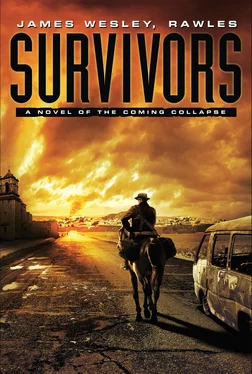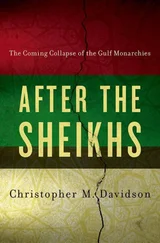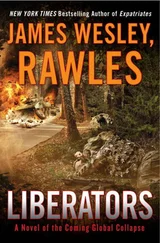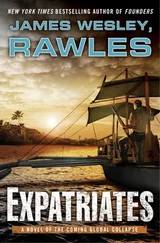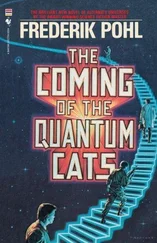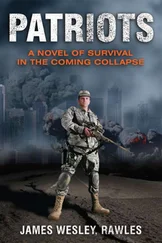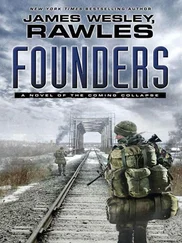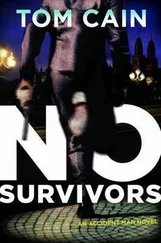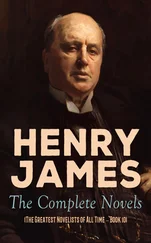As he approached Bloomfield, Andy realized that it was Sunday morning, and that his brother, Beth, and Kaylee would likely be at church by the time he reached the Refinery Road. So he pressed on to town, turned right at Blanco Road, and urged Prieto from a trot to a canter.
Lars, and Beth, Grace, Kaylee, and Shadrach were at church, while Reuben and Matthew were at home, guarding the ranch. As Andy rode his horse up to Berea Baptist, he could hear the congregation singing. He tied up his horse, unstrapped his pack from his saddle, and set it inside the church foyer. With his AK slung muzzle down, he slipped into the sanctuary. His hands were shaking with excitement.
The congregation was singing “Eternal Father, Strong to Save.” Demonstrating his flair for drama, Andy slipped in on Lars’s blind side unnoticed and stood behind him. Lars and Shadrach were in the second-to-last row of pews. Beth and Kaylee were one row farther forward. They were standing beside Grace and two other eight-year-old girls, holding hymnals for them as they usually did. Just after the hymn ended, Andy tapped his brother on the shoulder and said: “Sorry that I was a little late.” Lars gasped and grabbed Andy around his neck. Reaching into his shirt pocket and pulling out a plastic bag, Andy said, “Oh, I got those gas lamp mantles that you asked me to pick up for you on the way home.”
Kaylee nearly fainted. The church erupted into a huge commotion, with lots of hugs and back slapping. Shouts of “Praise God!’ spread like a wave across the church sanctuary. Even the two ladies in the nursery came out to give Andy a hug. Grace ran up to hug Andy around the waist, exclaiming, “Uncle Andy, we really missed you! You got so brown!”
The sermon, to mark Veterans Day, was in praise of military service and its biblical context. Andy and Kaylee sat holding hands all through it, intently gazing at each other, not paying much attention to the pastor’s words. After the closing hymn and benediction, Andy stood up and announced, “I’ve never been one to waste any time, so I’d like to ask everyone to stay for a brief ceremony.” Kaylee put on a huge smile and gave him a hug. Twenty minutes later they were married.
Moreland, Kentucky December, the Third Year
In parts of the territory controlled by the Provisional Government, the supply of gasoline preceded the restoration of grid power. This was the case in most of western Tennessee and western Kentucky. In what was later seen as a brilliant move, Greg Jarvis, the owner of Apogee Solar, in Moreland, Kentucky, ran an AC power line over rooftops two doors down to the gas station that was owned by his second cousin, Alan Archer. The station was open six hours a day, six days a week, and did a booming business. Before the advent of the ProvGov currency, regular gas was twenty cents a gallon, and both diesel and premium gas were twenty-five cents a gallon. These prices were in silver coin.
A prominent sign hand-painted on a four-by-eight sheet of plywood warned, “Silver coin or ammo only! No paper dollars, checks, debit cards, or credit cards accepted.” Archer and Jarvis worked out a credit arrangement with the Catlettsburg refinery. Under the terms of the agreement, they got gas and diesel in bulk at a 25 percent discount, and got their first two tank truck deliveries on credit. After that, they were able to pay in silver, from the proceeds of sales.
Within a few months, Jarvis and Archer launched several other enterprises. The first of these was a store selling packaged petroleum products-nothing larger than five-gallon cans, including kerosene, motor oil, and two-cycle fuel-mixing oil. By agreement, they charged the same prices as offered at the Catlettsburg refinery, but their profit came from buying in bulk at a discount. This store was located in one of the buildings that had “the big dang extension cord” draped over it-between Apogee Solar and the gas station.
The new Jarvis Lubricants store had previously housed a hardware store, but it had been stripped clean because the former owner had imprudently continued to accept payments in greenbacks. In the end he was left with a pile of worthless paper. He sold Jarvis the empty building and the remaining shelving for just two hundred dollars in silver coin. The new store was lit by a pair of 60-watt compact fluorescent lightbulbs. Nobody complained about the dim lighting.
Just as the crash began, Greg Jarvis had used a small-business loan to purchase 212 large REC brand photovoltaic panels at a closeout price. This served as his primary barter stock, through much of the Crunch. After the Crunch set in, he bought up as many deep-cycle batteries as he could find. Most of these came from a forklift company in Frankfort and from the golf cart fleets of two local golf courses. The shipment from Frankfort came by truck, COD, payable in silver. The batteries from the golf course owners were both barter transactions, paid for with compact solar power systems. One of these systems was installed on a golf cart, making the cart into a mobile, self-charging system.
Apogee also harnessed the excess power from their PV array that was not needed for their storefront by charging car and tractor batteries for a fee in their attached shop. This was a profitable business until the grid power was restored.
“Hold on, my friends, to the Constitution and to the Republic for which it stands. Miracles do not cluster and what has happened once in 6,000 years, may not happen again. Hold on to the Constitution; for if the American Constitution should fail, there will be anarchy throughout the world.”
— Daniel Webster
Andrew Laine was thrilled to be at the ranch with his new bride. After the hardships of the trail, putting in four-hour guard shifts five days per week seemed trivial. After dinner for several nights in succession, Andy described to Lars, Lisbeth, Grace, Kaylee, and the Phelps boys all of his experiences. He started with his time in Afghanistan and then Germany, France, England, sailing on Durobrabis , Belize, and his horseback ride through Mexico to Texas and New Mexico. They were captivated and asked him dozens of questions. Andy felt comfortable in answering most of them except for the details about his gunfights. Regarding those, he clammed up and gave them only sketchy descriptions.
During the quiet winter months he made a living by braiding custom rifle slings, belts, and bridles. Once supplies of parachute cord got scarce, he switched to braiding with horsehair. The coarse hair from horses’ tails was more time-consuming to work with, but it was attractive, so he found that he could demand more for the finished product. In addition to the regular ranch chores, Andy also made a living the same way that the Phelps boys did: by hiring himself out during hay harvesting time.
Five months after his return, Andy and Kaylee bought a used Ford pickup truck. It was one of the almost countless white pickups that were seen in great numbers, driven by technicians who serviced natural-gas wellhead compressors. These trucks were typically equipped with tall “safety flags” that looked much like those used on dune buggies. The flags came into use in the 1960s, following a couple of spectacular head-on collisions, as pickups topped the rolling hills of the region on narrow, gravel roads. The field reps were notorious for driving fast, and gravel roads are unforgiving. Hundreds of these ubiquitous white pickup trucks sat idle after the Crunch set in. They were one of the key assets still held by the field service and field engineering companies. Only a small percentage of the field reps were still at work, so this left the majority of the trucks essentially surplus.
Andy thought that a field service truck would be the best choice for reliable transportation, since spare parts and tires were abundant. He realized that as the Crunch continued, gas and oil would be sporadically available, but that unless or until tire factories went back into production, tires would eventually become the key commodity. As he put it, “Just wait another four or five years. By then a like-new set of tires will be worth as much as an entire vehicle. Mark my words.” He practiced what he preached and soon bought eight spare tires-already on rims and balanced-which he stored in a dark back corner of the barn. He eventually bartered for another complete pickup with a blown engine that was the same model year as their own, just for use as a parts rig. From this they could cannibalize parts and of course five more tires on rims.
Читать дальше
